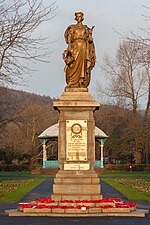Port Talbot Steelworks

Port Talbot Steelworks is an integrated steel production plant in Port Talbot, Wales, capable of producing nearly 5 million tonnes of steel slab per annum. This makes it the larger of the two major steel plants in the United Kingdom and one of the largest in Europe. Over 4,000 people work at the plant. The majority of the slab is rolled on-site at Port Talbot and at the Newport Llanwern site to make a variety of steel strip products. The remainder is processed at other Tata Steel plants or sold in slab form. The works covers a large area of land which dominates the east of the town. Its two blast furnaces and steel production plant buildings are major landmarks visible from both the M4 motorway and the South Wales Main Line when passing through the town.
Excerpt from the Wikipedia article Port Talbot Steelworks (License: CC BY-SA 3.0, Authors, Images).Port Talbot Steelworks
Memorial Road,
Geographical coordinates (GPS) Address Nearby Places Show on map
Geographical coordinates (GPS)
| Latitude | Longitude |
|---|---|
| N 51.56613 ° | E -3.76831 ° |
Address
Memorial Road
SA13 2DW , Margam Moors
Wales, United Kingdom
Open on Google Maps





